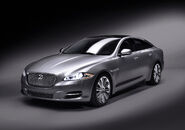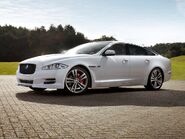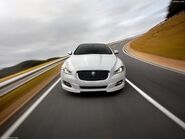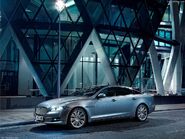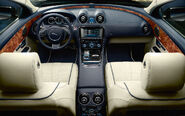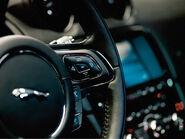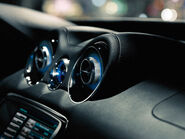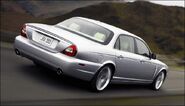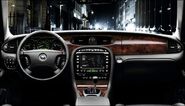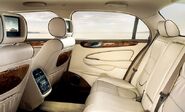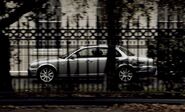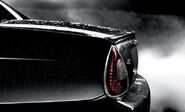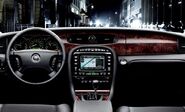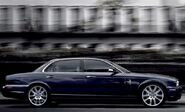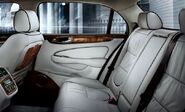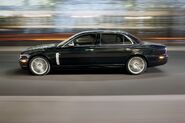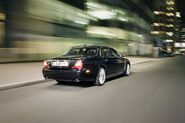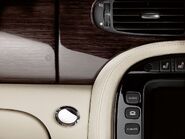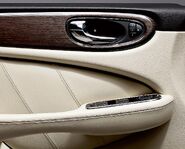
| |
| Jaguar XJ | |
|---|---|
| Jaguar | |
| aka | X351 Daimler Super Eight |
| Production | 1968 - Present |
| Class | Full-Size Luxury |
| Body Style | 4-door, 5-seat Sedan |
| Length | SWB: 201.7 in (5122 mm) LWB: 206.6 in (5247 mm) |
| Width | Excl mirrors: 74.6 in (1894 mm) Incl mirrors: 83.1 in (2110 mm) |
| Height | 57 in (1448 mm) |
| Wheelbase | SWB: 119.4 in (3032 mm) LWB: 124.3 in (3157 mm) |
| Weight | SWB Diesel: 1796 kg (3960 lb) Petrol: 1755 kg (3869 lb) Supercharged: 1892 kg (4171 lb) LWB Diesel: 1813 kg (3997 lb) Petrol: 1773 kg (3909 lb) Supercharged: 1915 kg (4222 lb) |
| Transmission | 6 speed Automatic, RWD |
| Engine | 3.0 litre Diesel V6 5.0 litre Petrol V8 5.0 litre Supercharged V8 |
| Power | V6 271 hp @ N/A rpm N/A lb-ft of torque @ N/A rpm V8 385 hp @ N/A rpm 380 lb-ft of torque @ N/A rpm V8 Supercharged (US market) 470 hp @ N/A rpm 424 lb-ft of torque @ N/A rpm V8 Supercharged 510 hp @ N/A rpm 461 lb-ft of torque @ N/A rpm |
| Similar | Maserati Quattroporte BMW 7 Series Mercedes-Benz S-Class Audi A8 Porsche Panamera Lexus LS Bentley Flying Spur Aston Martin Rapide Volkswagen Phaeton |
| Designer | 1st Gen: 2nd Gen: Geoff Lawson 3rd Gen: Geoff Lawson (finished by Ian Callum) 4th Gen: Adam Hatton under Ian Callum |
The Jaguar XJ is a series of full-size luxury cars produced by British automobile manufacturer Jaguar Cars (becoming Jaguar Land Rover in 2013) from 1968 to 2019. It was produced across five basic platform generations (debuting in 1968, 1986, 1994, 2003 and 2009) with various updated derivatives of each. From 1970 it was Jaguar's flagship four door model. The original model was the last Jaguar saloon to have had the input of Sir William Lyons, the company's founder, and the model has been featured in countless media and high-profile appearances.
See Autopedia's comprehensive Jaguar XJ Review.
Recent Changes[]
- For 2011, Jaguar is now offering the XJ Sentinel, an armoured version of the XJ LWB in conjunction with armouring specialists Centigon. Boasting a B7 level of ballistic protection, it can withstand 15kg (33 pounds) of TNT equivalent explosions and gunfire from an armour-piercing M61 AP. Obviously, armouring adds extra weight and the car now weighs 8377 lb (3800 kg) as a result. Still, the 385 hp naturally aspirated 5.0 litre V8 w/ 6-speed automatic can move the added heft to 100 km/h (62 mph) in 9.7 seconds. Other modifications include the beefier suspension with continually variable dampers and the bigger, more powerful brakes from the XJ Supercharged. The Sentinel will debut at the 2010 Moscow International Motor Show. [1]
- On July 10, 2009, Jaguar unveiled the fourth-Generation Jaguar XJ. On hand to make the reveal were Jay Leno and Elle MacPherson at the Saatchi Gallery in London.
- At the 2009 Shanghai Motor Show press conference in April, Jaguar unveiled a teaser shot of its next generation XJ. According to the British firm, the new XJ will be officially launched on July 9, 2009. It will also be the first Jag to feature the company's next-generation aerospace-inspired, aluminum body architecture which will greatly reduce the XJ's already low weight. Under the hood, the new Jag will also be equipped with Jaguar's new Gen III petrol and diesel engines, first seen in the facelifted XF and XK, including the 3.0 litre V6 diesel with 240 and 275 hp and the 5.0 litre supercharged V8 that produces 510 hp. [2]
Styles and Major Options[]
- XJ8
- XJ8 L
- Vanden Plas
- XJR
- Super V8
Pricing[]
Add more fields as necessary.
| MODEL Trims | |||||
|---|---|---|---|---|---|
| XJ | XJL | XJ Supercharged | XJL Supercharged | XJ Supersport | XJL Supersport |
| MSRP | |||||
| $72,500 | $79,500 | $87,500 | $90,500 | $112,000 | $115,000 |
| Invoice | |||||
| $Price1 | $Price2 | $Price3 | $Price4 | $Price5 | $Price6 |
Gas Mileage[]
Add more fields as necessary.
As seen on the FuelEconomy.gov website, the City/Highway MPG averages are as follows:
| Trim | |||
|---|---|---|---|
| Trim1 | Trim2 | Trim3 | Trim4 |
| MPG | |||
| c/h | c/h | c/h | c/h |
Engine and Transmission[]
Specifications, details, graphs, pictures and other information regarding the powertrain is placed in this section.
Performance[]
Please make sure to write information of the vehicle's performance in a third-person point of view. This section should include information about the car's acceleration figures, handling, braking, etc.
If using information gathered from Road Test articles from a reputable automotive source, then please make sure to cite the quote.
Reliability[]
- RECALL ALERT: On November 24, 2010, Jaguar announced a recall affecting 6,475 U.S.-spec units manufactured between July 28, 2009 and November 3, 2010 due to a faulty front wiper arms that weren't sufficiently torqued during assembly. According to the NHTSA, during operation, the securing nuts could fail, resulting in a loss of synchronization and ultimately lead to a clash of the wiper arms. Furthermore, the wipers could detach from the car and leave the driver blind in the middle of the pouring rain. Jaguar urges affected owner to visit their local dealer to have the problem assessed. The fix will be carried out free of charge. The recall is set to commence on December 13, 2010.[3]
Safety[]
Road accident statistics on a model-by-model basis from the UK Department of Transport show that the XJ series Jaguars are the safest cars on UK roads (measured in terms of chance of death in an accident) —between three times safer than the safest Volvo models and only matched by the Mercedes-Benz S-Class and Land Rover. This is backed up by the popularity of the car in the world of banger racing, the early Series I/II/III models in particular for their combination of crashworthiness and high performance.
Photos[]
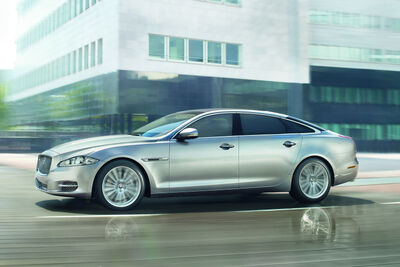
The armoured luxury of the Jaguar XJ Sentinel.
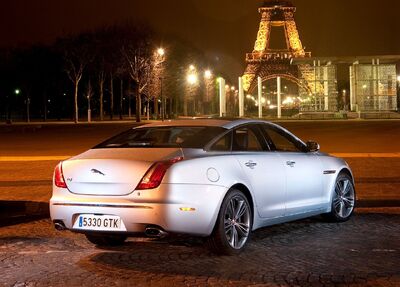
Sport Pack[]
2012 refresh[]
Add Photos of the vehicle here.
Please make sure not to use copyrighted photos.
Colors[]
List the colors that the particular <MODEL> is offered in.
Main Competitors[]
Hybrid Models[]
If there are hybrid versions of this vehicle manufactured, then please elaborate a little bit on it here.
Unique Attributes[]
If there are any features of this vehicle that sets it apart from other vehicles in its class, then mention those unique attributes here.
Interior[]
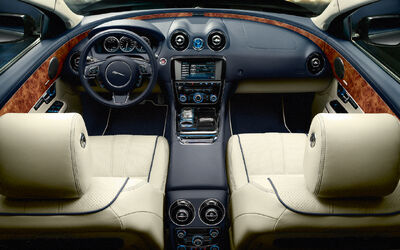
The new XJ features an innovative, all-LCD dashboard and console displays. The dashboard can be configured to display various virtual dials in addition to the obligatory speedometer. The console display presents different views to the driver and passenger, including control of a sophisticated video and audio system.
Resale Values[]
Add more fields as necessary.
| <MODEL> Year | |||
|---|---|---|---|
| Year X | Year X-2 | Year X-3 | Year X-4 |
| Resale Value | |||
| $ | $ | $ | $ |
Criticism[]
WARNING: This passage may contain information with strong opinions that may anger fanboys.
Design[]
These days, an automotive brand's identity often resides in the design details, and the new XJ's designers realize this. They've given us a new take on an ultra-luxury sedan; most of it is fresh but, unfortunately neither the package nor the details ring true. This is odd for a company who should have the DNA "nailed" after over a half-century of big sedan design language upon which to draw.
Generally, every single reference (or even "brief nod") to Jaguar tradition is absent. Consider for a moment that, with Rolls-Royce and Bentley going their separate ways once again, and Rolls-Royce having crossed the line from the real world into the Neverland of extreme bad taste back in 2003, there is a huge vacuum in the market for a high end Brit luxury car with a traditional package. Jaguar have ignored this opening to give us a car that's the automotive equivalent of a wine bar's slop bucket--a blend of different notes of varied vintages and sources that, in the end, courts, not greatness, but disposable, forgettable waste.
The silhouette, especially the greenhouse, seems to have been penned in homage to the Audi sedan range that are already long in the tooth. The lower body, too, has a Teutonic quality to its proportions, with the wheels being pushed out more towards the ends of the body and the generic shape of the wheel openings.
The front grille design seems to have lost its historical cues (which could be said of most of this design)since the introduction of the XF. Too much chrome; too sharp-edged; proportionally too large (again an Audi similarity here). And when are designers going to stop trying to impress each other (adding to the observer's confusion!) with wacky headlight designs? Do the styling bosses run Japanese robot cartoons in the company cafeteria during lunch breaks?
The front aspect is generic in character and the above-mentioned grille and headlight graphics both appear to be over-compensation; the rear offers scant relief. Proportionally, it's somewhat inoffensive, but the Toyota-ish up-and-over taillights sacrifice function for tastelessness.
The use of the leaper as a rear logotype (begun on the XF, too) sends the viewer's eyes on a journey to the Northwest, where there's little to provide comfort. Why this jarring element should find its home on an otherwise rigidly symmetrical rear fascia is anyone's guess.
There may just be a bit too much guessing going on here, on the part of the designers (who seem to have lost the key somewhere, to a degree not seen since the introduction of the ultimate Elephant-designed-by-blind-men XJ-S), and in the case of the unfortunate viewers whose wallets and need for social superiority haven't yet clouded their sense on common sense, tradition, and good taste.
The interior does not disappoint, whether the observer's impression of the exterior leaves him horrified or intrigued, depending upon his preferences. There seems to be a feeling of "we did it because we could" excess in the details. One feels like Captain Nemo at the controls of the Tata Nautilus--Flagship of the Fleet--while the eyes look for a restful place to settle on the instrument panel and its vicinity. There's a definite Jules Verne-lost-in-Delhi quality to all the outrageous juxtaposition of the overly-fussy chromed, tanned, and knurled details. Perhaps it's best to park it facing the sea, so the simple horizon gives one's eyes respite.
Ironically, the "new" XJ will probably crowd the streets and lanes everywhere that folks need to be seen with their latest pricey bauble. All that design and engineering work in the service of fashion baublery...
Tata/Jag didn't get anything right on this one, design-wise, and it's a sad price to pay for a car whose performance, especially in supercharged 5-litre trim, promises a genuine revelation.
Generations[]
Fill in as many as appropriate. Add more if necessary and pictures wherever applicable.
Please make sure NOT to use copyrighted pictures.
Fourth Generation: (2010–2020)[]
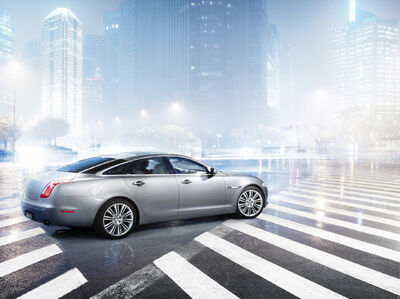
The Jaguar XJ (X351) was the fourth and final generation of the Jaguar XJ saloon manufactured by British automobile manufacturer Jaguar, and later Jaguar Land Rover. Announced in 2009, and going on sale from 2010, the X351 combines revised styling with underpinnings of the previous X350 generation. The model was discontinued in 2019 (2020 model year).
The X351 is one of the cars used by the British royal family and a Sentinel (1 of 10) was used for transporting two former UK Prime Ministers namely David Cameron and Theresa May. The Prime Ministerial Car, aside from having classified security measures, has armoured under plates and engine plates.
Overview[]
Design[]
The XJ was designed at Jaguar Land Rover's Whitley plant in Coventry, by a team led by design director Ian Callum. Design work began in 2005, with final design approval taking place in November 2006 and the design being frozen in the first half of 2008. The new design is a complete departure from any earlier XJ model, although mechanically the car is a development of its predecessor.
Models[]
In addition to the standard version with a 3,035 mm (119.5 in) wheelbase, a long-wheelbase version was available with a 3,160 mm (124 in) wheelbase. At the 2010 Moscow Motor Show, a high security version of the car called the XJ Sentinel was introduced. This is an armoured version of Long Wheelbase XJ with B7-level ballistic protection as well as providing protection against 15 kg TNT or equivalent explosive. It has the 5.0 L supercharged V8 engine shared with the XJ Supersport having a power output of 510 PS (375 kW) and 19-inch wheels with Dunlop Self Supporting Technology run-flat tyres.
However, unlike other full-size flagship executive cars, the long-wheelbase variant was designed first and is expected to make up 67 percent of sales in the United States market.
| Models | Luxury | Premium Luxury | Portfolio | Supersport | Sentinel |
|---|---|---|---|---|---|
| Engines | 3.0 L diesel V6 | 3.0 L diesel V6, 5.0 L V8 | 3.0 L diesel V6, 5.0 L V8, 5.0 L supercharged V8 | 3.0 L diesel V6, 5.0 L supercharged V8 | 5.0 L supercharged V8 |
| Wheels (standard) | Meru 18-inch alloy | Aleutian 19-inch alloy | Kasuga 20-inch alloy | Mataiva 20-inch alloy | Aleutian 19-inch alloy |
Equipment[]
Driver information and entertainment is provided by a Bowers & Wilkins 1,200-watt, 20-speaker Dolby 7.1 surround-sound system and a bi-directional touch screen display - on which the driver can only see the vehicle functions (and satellite navigation data), but a front passenger can simultaneously view a DVD movie or a television transmission. Standard equipment levels on the United States-spec XJ L with the base engine includes a panoramic dual-pane moonroof, lane-departure warning, navigation, quad-zone climate control and power sunshades, which is considered to be generous at this price point compared to other flagship executive saloons.
Third Generation (2003-2009)[]
X350[]
Although major revisions (through the X300 and, particularly, the X308 updates) kept the Mk 2 competitive in some areas against its rivals, the basic design and 'hard points' of the Mk 2 dated back to 1986 which meant the car was very quickly being outclassed and losing ground to its rivals, many of whom were now two generations on from the MK 2 XJ. For example, since the Mk 2 was unveiled in 1986 (at the same time as the Mk 2 BMW 7 Series (E32)), BMW had launched Mk 3 (E38) and Mk 4 (E65) versions in 1994 and 2001 respectively, while Jaguar was still producing the Mk 2 XJ.
In September 2002, the all-new third generation XJ (known as X350) arrived in showrooms. While the car's exterior and interior styling were traditional in appearance, the car was completely re-engineered. The new car also saw the return of the fabled XJ6 badge, and with it 6-cylinder power, albeit in a V-configuration.
Design and Engineering[]
Like the Audi A8, the X350's chassis and body are constructed from aluminium. While some steel is used in some places throughout the chassis, the X350 has an aluminium monocoque/chassis similar in general design to a conventional steel structure, but with two differences; its underbody components are bonded together with aerospace-grade epoxy adhesives while around 3,200 self-piercing rivets are used to create the new XJ's unibody. A conventional steel body would be welded, more because of the fact steel had a higher melting point. Interestingly, the construction method of X350 is different to the one Audi employs for the A8, but both methods are considered advanced.
On its own, the current XJ's bodyshell weighs about the same as a contemporary Mini. If the car were made of steel, it is estimated that it would weigh 40% more.
Some of the styling features that distinguish the X350 from the previous XJ include the outer headlights, which are larger than the inner headlights, and wheels which are pushed closer to the corners of the car (due to an increased wheelbase), both like the original Mk 1 XJ. Also, the X350 dispenses with the third side window of its predecessor, reverting back to two side windows like the Mk 1. The curve in the rear door resembles that of the Jaguar saloons of the 1950s and 1960s.
Engines[]
The V8 engines remained in the new model, but were now the revised and more powerful versions found in the 2002 S-Type. The 290 Bhp 4.0 litre and 370 Bhp 4.0 litre supercharged engines from the X308 Mk II were replaced by the S-Type's 300 Bhp 4.2 litre and 400 Bhp 4.2 litre supercharged units respectively, while a new 3.5 litre V8 was also introduced. Derived from the 3.2 litre engine of the previous model, it produced 265 Bhp.
The 240 Bhp 3.2 litre V8 from the previous model was replaced by the 240 Bhp 3.0 litre V6 from the X-Type and S-Type. The V6 powers the XJ6, while the XJ8 is powered by a naturally-aspirated V8. The XJR is powered by a 4.0 litre V8. The XJ6 is the only X350 model not sold in the Americas.
2005 also saw the introduction of the first ever diesel-powered XJ Jaguar, a notion that was unthinkable only a few years ago and a model which still causes constenation amongst traditional Jaguar fans and owners. Featuring the same Ford-Peugeot-developed 2.7 litre twin turbo V6 unit found in the S-Type, the engine produces 204 Bhp and 321 lb ft of torque. Called the XJ TDVi, this model is often praised not only as the most powerful diesel against similarly powered rivals, but also the best diesel-engined car in the world until the all-new Mk 8 Mercedes-Benz S320 CDi reclaimed that title.
Overview[]
Despite some critics' concerns that the XJ's styling is dated, the general consensus is that the X350 is an efficient car featuring sharp and engaging handling, a smooth ride and powerful engines, particularly the V8 and diesel engines.
The top-line XJs are branded as Vanden Plas (in North America) and Daimler (everywhere else).
2006 Jaguar Super V8 Portfolio
The Super V8 is the fastest and most expensive model, with the XJR a close second. The Super V8, which debuted in the 2004 model year in the new X350 body style, is essentially a long-wheelbase, supercharged XJ8. Its primary competitor is the Mercedes-Benz S55 AMG. A distinctive wire mesh grille and chrome-finished side mirrors set the Super V8 and the XJR apart from the less expensive XJ sedans.
All North American XJs are powered by a 300 hp (224 kW) naturally aspirated engine. A 400 hp (298 kW) supercharged from 4.2 L V8 engine is optional. The valvetrain has a dual overhead cam design with four valves per cylinder. The top speed is limited electronically.
In early 2005, Jaguar announced its most exclusive, powerful and expensive XJ sedan since it ceased V12 production. Called the 2006 Super V8 Portfolio, it is a limited-edition trim level of the flagship Super V8 sedan. It debuted at the New York International Auto Show in March 2005, and is the most expensive Jaguar sedan produced to date, with a base price of US$115,995. The Portfolio features added power as well as exterior and interior enhancements, including a DVD player and 7-inch screens in the rear headrests. The Super V8 Portfolio, aimed at American and Canadian markets, became available in August 2005. It is available in only two new, limited colors: Black Cherry and Winter Gold. The equivalent model is sold under the name Daimler Super Eight and Daimler brand on the European and other international markets.
The Super V8 Portfolio is powered by Jaguar's supercharged 400 hp, 4.2 L, 32-valve, AJ-V8 engine. Top speed is 155 mph and the Portfolio has a 0 to 60 mph acceleration time of five seconds.
2009 Jaguar XJ Portfolio
Second Generation (1986 - 2003)[]
XJ40[]
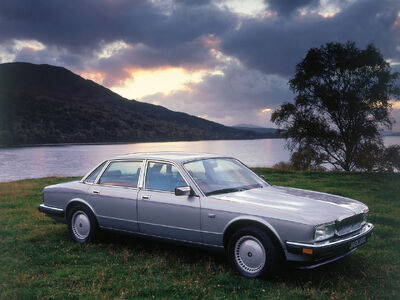
1994 Jaguar XJ40 'Sovereign'.
All through the 1970s, Jaguar had run Project XJ40, which was an all-new model meant to replace the Mk 1 XJ6. Due to problems at British Leyland and the fuel crisis, the car was continually delayed. Proposals from Jaguar's in-house designers and Pininfarina were made. Eventually, it was decided an internal design would be carried through to production.
This car was finally released in October 1986 with (in European markets) controversial square headlamps, a carryover from the 1970s development. It was considered more evolutionary than revolutionary, and had to fight off a new competitor: the newly upsized BMW 7 Series. While the British press favoured the Jaguar, the XJ40 tended to lose comparison tests run by German publications. Only six-cylinder models were initially offered: a 2.9 L (in Europe) and a 3.6 L. The V12 (XJ12) and a long wheelbase model, including a high-roofed Daimler Majestic model destined for official use (one was used by the British prime minister), were again delayed, launching at the very end of the XJ40's life. The delay in fitting the V12 engine was due to the design of the engine bay which was too narrow to allow a V formation engine, said to have been designed deliberately in that fashion as the Jaguar V12 was by then an aging unit and the designers feared that their parent company would insist use of a an engine based on the Rover V8 engine (a DOHC version of this engine was designed but never produced). Immediately after Fords takeover in December 1989, work began on redesigning the engine bay to accommodate the V12. Ironically Jaguar was later to find itself one again in common ownership with Land Rover, this time under the Ford umbrella, but having since developed their own V8, they saw the reverse happen with a version of their engine fitted to Land Rover models
The single cam 2.9 L straight-6 engine found in Europe was a derivative of Jaguar's legendary 6.0 L V12 HE, but it proved to be underpowered and thirsty compared to the 3.6. L Frequent timing chain failures were also a problem. The engine was later replaced with the 3.2 L, based on the durable 3.6 L, which then became the 4.0 L.
1989 Mk 2 (XJ40)[]
In 1989 the model range was revised with the deletion of the 2.9 litre engine, replaced at the low end by a twin-cam 3.2 litre version. The 3.6 was upgraded to 4.0 litres. The most obvious interior improvement was replacement of the often unreliable digital dashboard with conventional analogue instruments.
1994 Mk 2 (X300)[]
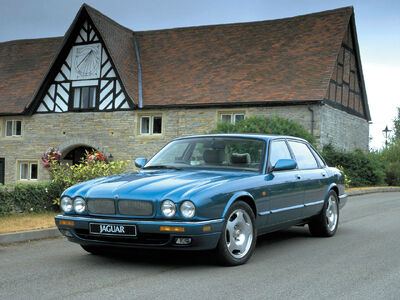
1994 XJR
By the late 1980s Ford had become Jaguar's owner, and with an all-new replacement still years away, Ford ordered the XJ40 to be facelifted and "retrolutionized", reintroducing the style of the popular Series 3. The X300, as it was known, was redesigned by head designer Geoff Lawson and was launched as the XJ6 and XJ12 for the 1995 model year.
In addition, a supercharged version of the straight-6 was offered and badged as the XJR. This was the first supercharged Jaguar in the company's history and only the second car Jaguar ever made that used forced induction — apart from the extremely rare and expensive Jaguar XJ220.
The center section (namely the doors and glass area) was shared with the original Mk 2 (XJ40) but the X300 saw the XJ6 revert back to a traditional fluted bonnet and 4 individual headlights. The front and rear wings, bumpers and bootlid were also redesigned. The interior remained more or less the same as before. The engines were basically the same 3.2 litre and 4.0 litre units found in the XJ40, but were mildy revised to further increase power and refinement. It was this generation that saw continued improvement in build quality.
1997 was the final year of production for the XJ6 and XJ12. Jaguar switched exclusively to an all-new V8 engine when the XJ8 was introduced at the end of 1997. The last Jaguar to be powered by a V12 engine was a black XJ12 that left the production line on April 17, 1997. It now resides in the Jaguar Museum. Only 3,400 XJ12s were produced in the X300 body style, making it rarer than V12 rivals such as the BMW 750iL and Mercedes-Benz S600. The XJ12 was visibly differentiated from the XJ6 not only by a badge on the rear deck lid, but also by a "V12" badge on each side of the central pillar.
1997 Mk 2 (X308)[]

2002 Jaguar XJ Super V8.
1997 saw the Mk 2 XJ revised for a final time, and this time the car (known as X308) had changed more over the X300 than the X300 did over the XJ40. The exterior styling was mildly revised, the only real notable change being the new front oval indicators, grille and front bumper.
The biggest changes lay under the bonnet and inside. An all-new, and hugely praised, V8 engine was introduced and was available in 3.2 litre, 4.0 litre and 4.0 litre supercharged versions. The new 8-cylinder engines, built in Bridgend, Wales, not only saw the end of 6-cylinder and 12-cylinder power, but the legendary XJ6 moniker was no more; the cars with naturally-aspirated engines were now called XJ8. The new performance figures were 290 BHP and 240 BHP for the naturally-aspirated 4.0 litre and 3.2 litre versions respectively and 370 BHP (276 kW) for the supercharged (compressor) version.
The interior was changed greatly, featuring an all-new dashboard. However, the basic car was now 12 years old and some now considered the limited legroom for rear passengers, which was an issue back in 1986, to now be a real Achilles' heel, especially when compared to competing models from BMW and Mercedes-Benz. Nonetheless, many overlooked this issue, citing the continued Jaguarness and Britishness of the new interior as a preferable place to spend time when compared to rivals. However, for those who considered rear legroom to be a very real issue, there were long-wheelbase versions known as the Sovereign (and, at the very top of the range, the supercharged Daimler-also known as the Vanden Plas in the United States).
Although the new car was improved over the X300 and featured revised dynamics (including an excellent ride) along with its excellent new engines, the Mk 2 was now 12 years old and was launched at the same time as the all-new Mk 7 Mercedes-Benz S-Class (W220). Although the XJ was considered by critics as still competitive in some areas in many roadtests the X308 was essentially outclassed by the new S-Class, a car many journalists proclaimed to be the 'best car in the world' at launch.
However, despite being outstripped the Mk 2 XJ was considered to have a 'special' and unique feel compared to the somewhat clinical feel of the S-Class and other German rivals, and for many purchasers this was reason enough to buy the XJ.
The Mk 2, considered by some to be the Coventry marque's finest export ever, soldiered on until its all-new aluminium-bodied replacement (X350) was unveiled in 2002.
Interesting to note is that the XJR-version featured an 5 speed automatic transmission from the Mercedes-Benz AMG E55 and other high power Benz models.
A limited-edition XJR called the XJR 100 was available in 2002 only. The XJR 100 came only in black (paint as well as exterior trim) with black leather interior. Features exclusive to the XJR 100 were unique alloy sport wheels, gray-stained birdseye maple trim, red badges and red stitching throughout the interior. Only 500 were produced.
First Generation/Origins (1968 - 1986)[]
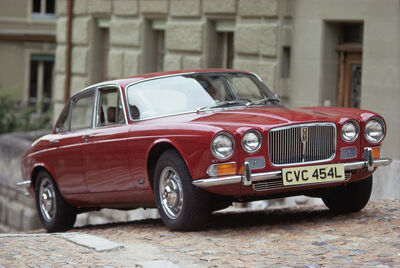
Series 1 1968 - 1972[]
At the time, the XJ6, using 2.8 L (2790 cc/170 in³) and 4.2 L (4235 cc/258 in³) versions of Jaguar's renowned XK engine, replaced most of Jaguar's saloons, which, in the 1960s, had expanded to four separate ranges. The upmarket version was marketed under the Daimler brand and called the Daimler Sovereign. The 'XJ' designation was from the car's code name during development, standing for Experimental Jaguar.
Main Competitors[]
The car was introduced in September, 1968, in a series of television advertisements featuring Sir William. In these spots, he memorably referred to the car as "the finest Jaguar ever." The XJ12 version, with a 5.3 L V12 engine, was launched in 1972, with just 3,235 built.
Series 2 1973 - 1979[]
Normally known simply as the "Series II" the XJ line was facelifted for 1973. A 3.4 L (3442 cc/210 in³) version of the XK engine was reintroduced in 1975.
Main Competitors[]
- BMW Bavaria
- Mercedes-Benz W116
- Peugeot 604
- Volvo 164
The XJ12 version, with a 5.3 L V12 engine, was again part of the lineup along with long-wheelbase models and a coupé, now considered a collector's item due to its rarity. The top 12-cylinder Daimler was called the Double Six. The Series II launched in the 1974 model year in the United States.
These Series II models were known for their poor build quality while part of the British Leyland group as well as problems inherent in the design of certain Lucas-sourced components. On television, the Jaguar XJ Series II was immortalized in the TV show Minder.
Visually, apart from the longer wheelbase and available "XJ12" badge, the Series II cars are differentiated by a smaller grille. 91,227 were produced, just 14,226 of them with the V12 engine, when the series II ended in 1979.
XJ Coupe[]
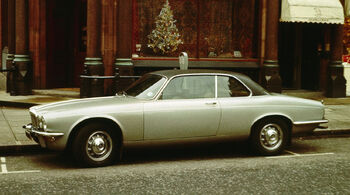
A tiny 8,378-car run of 2-door XJ coupes with a pillarless hardtop body called the XJC was built between 1975 and 1978. The coupe was based on the short wheelbase version of the XJ. The longer coupe door was made out of a lengthed standard XJ front door (the weld seams are clearly visible under the interior panels were two front door shells were grafted together with a single outer skin). A few XJCs were modified by Avon into convertibles with a retractable canvas top, but this was not a factory product. Both six and twelve-cylinder models were built, 6,505 of the former and 1,873 of the latter. Jaguar had intended to introduce the car as early as 1973, but problems with window sealing delayed production. Even with the delay, these cars suffered from water leaks and wind noise. The delayed introduction, the labor intensive work required by the modified saloon body, the higher price than the four door car, and the early demise promulgated by the new XJ-S, all ensured a small production run. All coupes came with vinyl roofs as standard. Some have said this is due to the rough welds around the windows of the roof, however many owners have removed these roofs and found no such rough welds. Other explainations point out that all V12 Jaguars received vinyl roofs at this time to signify the introduction of fuel injection, but this doesn't explain the vinyl roof on the 6 cylinder cars. Today about half of XJCs do not have the vinyl roof.
Series 3 1979 - 1992[]
In late 1979 the XJ was facelifted again, and was generally know as the "Series III". The car incorporated a subtle, and very well received, redesign by Pininfarina of the long-wheelbase platform and three engine variants including the 5.3L V12, the 4.2L inline 6 and 3.4L inline 6. The V12 and the larger 6 cyl. incorporated Lucas licensed Bosch fuel injection while the smaller 6 cyl. made do with carburetors. The smaller 6 cyl. engine wasn't offered in the U.S. The short wheelbase sedan and coupé had been dropped during the final years of the Series II XJ. This style of Jaguar saw the company through from its darkest days toward its emergence as an independent company under John Egan who oversaw a marked improvement in build-quality and reliability for the company's products.
In 1982 the interior of the XJ underwent a minor update. Also in 1982, the upscale Vanden Plas, a model designation that is still used today for the top-level XJ sedan, was introduced in the U.S. market.
The last Series III XJ with a six-cylinder engine was produced in 1987. Production of the Series III XJ continued until 1992 with the V12 engine. 132,952 Series III cars were built, 10,500 with the V12 engine.
Main Competitors[]
- Alfa Romeo Alfa 6
- BMW 7-Series
- Cadillac Seville
- Lincoln Continental
- Mercedes-Benz W126
- Peugeot 604
- Saab 900
- Volvo 760
Worldwide[]
If the vehicle is sold in other markets worldwide, then this is the section to mention that information. Also, mention if the <MODEL> goes by another name in these other markets.
Design quirks and oddities[]
Refer to any pop-culture tidbits about the vehicle in this section.
Armoured version[]
Jaguar unleashed a fully-armoured Jaguar XJ. It featured run-fla tyres, self-sealing fuel tank, tamper-proof exhaust, under-floor kelvar protection, titanium-armoured roof, balistic-steel armour, fully retuned variable assisted steering, bullet-proof borosilicate glass and six-piston brake calipers. OPn the inside, occupants get oxygen supply and an intercom system.
Awards[]
2010 Top Gear Luxury Car Of The Year
See Also[]

| ||
| JAGUAR | ||
|
Tata Motors | Jaguar | Land Rover | Hispano Carrocera SA | Tata Daewoo Commercial Vehicle | Daewoo Bus Current Models: XF (R) · F-Pace · F-Type · E-Pace · XE · I-Pace Historic Models: X-Type · E-Type · XJS · XKSS · XK120 · XK140 · XK150 · XJ220 · 240 · 340 · Mk. VII · Mk. VIII · Mk. IX · Mk. X · Mk. V · Mk. IV · Mark 2 · Mark 1 · 3.5 Litre · 2.5 Litre · 1.5 Litre · S-Type (1963-1968) · 420 · S-Type · SS100 · XJR-15 · XJ Concept Cars: C-XF · R-Coupe · RD-6 · Fuore XF 10 · Pirana Concept · XK180 Concept · F-Type Concept · XK-RR Concept · XK-RS Concept · Concept Eight · XJ Limo Green Hybrid Study Concept · XJ75 Platinum Concept · C-X75 Concept · C-X16 Concept One-Offs: XJ13 Racing Vehicles: C-Type · D-Type · XJR-5 · XJR-6 · XJR-7 · XJR-8 · XJR-9 · XJR-10 · XJR-11 · XJR-12 · XJR-14 · XJR-16 · XJR-17 · XJ-S · R1 · R2 · R3 · R4 · R5 · XKR GT3 · XKR GT2 · RSR XKR GT | ||
| Sir William Lyons | Corporate website | A brand of the Tata Group |
External Links[]
News & References
- Jaguar Super V8 wallpapers and videos
- Geneva '08 Preview: 2009 Jaguar XJ Portfolio
- Jaguar: Next XJ "closer to Bentley than BMW"
- Jaguar Revises XJ Lineup for 2009MY in Europe
- Jaguar updates XJ range
- 2010 Jaguar XJ: Official Teaser Photos and Video
- All-New Jaguar XJ Teaser Details & Video Released
- 2010 Jaguar XJ: We get hands-on with Coventry's new big cat
- 2010 Jaguar XJ: The New Cat Revealed!
- Carscoop Jaguar XJ Mega Gallery with 100 High-Res Photos
- Jaguar XJ's dual-view infotainment display "technically illegal" in the United States?
- 2010 Jaguar XJ US pricing announced at Pebble Beach debut
- Jaguar unleashes XJ Sentinel for all your armored needs
Enthusiast Sites & Discussion Forums

|
This page uses some content from Wikipedia. The original article was at Jaguar XJ. The list of authors can be seen in the page history. As with Autopedia, the text of Wikipedia is available under the GNU Free Documentation License. |





